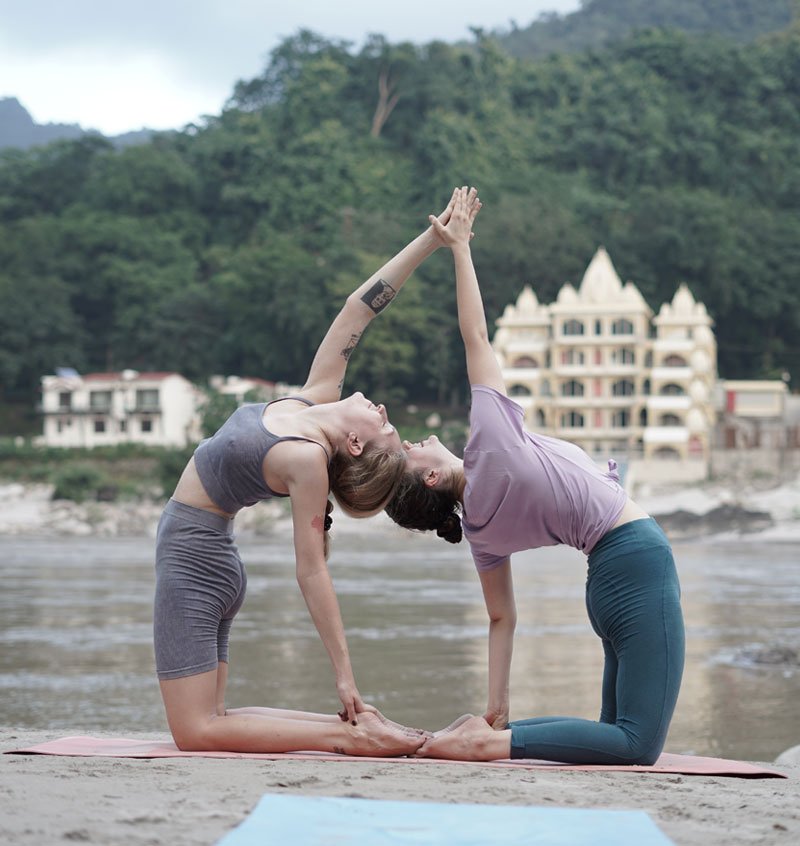What is Utthita Trikonasana ?
Introduction Of Utthita Trikonasana
Utthita Trikonasana is one of the more popular triangle poses, that stretches the entire body along with the spinal cord. The pose is exactly, what its name depicts it to be. The body forms various triangles. The legs make a triangle with the floor, there is a small triangle created between your arm, front leg, and the upper body, and so on. It is a stability providing asana and a chest opener as well. Utthita Trikonasana also stretches the hamstrings, back muscles, and the abdominal muscles.
Like all other times, you may be interested in knowing the meaning of the asana name. It has definitely come down from the Sanskrit verses.
Utthita means ‘extended’, Trikona means ‘Triangle’, and lastly Asana means ‘pose’. So, that sets the meaning right. Through this pose, you can attain mastery over your entire body, both upper and lower. It is a more intense variation of the Trikonasana. You need more flexibility of the hamstrings and the waist. Moreover, it is a part of the Ashtanga Primary series.
Read More: Why Is Kundalini Yoga Dangerous? The Truth About Its Risks and Rewards
Let us learn how to do it.
How To Do the Utthita Trikonasana?
You can master the asana in a few days, under the tutelage of an experienced yoga teacher.
- You have to start in the mountain pose or the Tadasana. You have to stand with your feet, hip-width apart. About 4-5 feet is ideal. You have to extend your arms, so that they are parallel to the ground. Your palms should face downwards.
- If you are starting from the right, the right foot should be perpendicular to the end of the mat, and the left foot should be at 45-degrees.
- Inhale deeply, and then exhale and bend your body at the hips. If you are standing with your right foot extended, bend over and touch the calf muscles of the right leg or the ankles, whichever is feasible.
- Your left arm should be pointing in upward direction. The left arm should be forming a straight line with the arms and the shoulders.
- Now, look up towards the ceiling. You can also gaze at the hands. Drishti or gaze is really important in Ashtanga Yoga.
- After you hold the position for some time, you can come back to your normal position, while inhaling. Repeat on the other side.
You need to practice normal breathing while performing the asana.
What are the Modifications and Variations of Extended Triangle Pose?
Modification Of Extended Triangle Pose
If you are a beginner in yoga, you may feel a huge strain on your obliques and the hands, or legs while trying this asana. So, the following tips might help you.
- If you find it hard to reach the ground or the feet, while bending sidewards, you can keep yoga blocks and rest your palm on them.
- Initially, you can reduce the distance between the feet, and bend the knee a bit, although this is not the best practice.
- If you want to gain better balance, then you should support the other stationery leg against the wall, and bend the body on the opposite side. This will give you extra support.
Variations Of Extended Triangle Pose
You can do various variations of Utthita Trikonasana, without exerting much pressure on the hip joints or the arms. Yoga blocks are the best thing to use, apart from a stool for resting the palms of the hand. You can also change the alignment of the hands as a possible variation, to exert less stress on the upper body or the torso. Baddha Trikonasana is a great option.
You have to take deep breaths, and exhale when you are bending and holding the final pose. Your Drishti should be towards the ceiling or towards the fingertips, or Hastagrahe Drishti.
Safety Precautions Decoded
What are the safety precautions while doing Utthita Trikonasana?
Here we are going to under what you need to undertake the proper technique to do Utthita Trikonasana. If you maintain all the dos
and don’ts, you will not get injured as well.
- If you extend your legs too far from one another, then you will not feel the full benefits of the pose. The stance should be as wide, as you can handle. It should help you to maintain stability.
- When you are rotating the foot, the thigh of the respective leg also has to rotate in the same direction.
- Do not lock your body unnecessarily in the position. Relax and do the pose or asana.
- You have to remind yourself to open the chest cavity, when you are gazing towards the upward direction. Also roll your shoulders back a bit, while doing it.
- You must ensure to energize your oblique muscles, before you attempt the pose. It will help you to maintain both your body’s balance and stability.
- The practitioner should also work on the triceps, to elongate the hands and create a triangle shape with the body.
- You should not fold the legs while doing this asana. If you are unable to reach the feet, you can hold the legs or calf muscles as well.
- This is not a forward bending pose, but a back bending one. So, you should always bend sidewards. The body should form the shape of an ‘I’, rather than a ‘C’.
- You have to engage the core muscles and thigh muscles, to get into this pose.
Who Can Do This Asana and Who Cannot?
If you are and advanced practitioner, or have been practicing other forms, Utthita Trikonasana will be easy. You have to practice a few times, before you can get that perfect pose. For all others, read this:
- If you have high blood pressure, you must not raise your arms towards the top.
- If you have migraine, you must not fix your gaze towards the hands or the ceiling. You can look towards the front side.
- Do not strain your neck much, while doing the asana, as it might lead to sprain.
- You should always use props while doing this asana initially.
- If you had slip-disc, neck injury or a back injury or surgery recently, you should avoid doing the asana.
Read More: Everything You Need to Know About Kundalini Yoga Teacher Training
Benefits of Extended Triangle Pose – Utthita Trikonasana
You will get a lot of therapeutic benefits from the asana. The following are stated below:
- It is extremely good for the expansion of the chest muscles and the shoulders.
- It can also increase its lung capacity.
- If you want to improve digestion and also lose weight, this is a great option.
- Regular practice of this asana can strengthen the legs, thighs and the back.
- It also improves the blood circulation within the body.
- If you suffer from stress and anxiety, you should practice this asana regularly.
- It opens the heart chakra, sacral chakra and the root chakra.
Deepen Your Yoga Practice with Hari Om Yoga Vidya School
Located in the heart of Rishikesh, Hari Om Yoga Vidya School is a place where ancient yogic wisdom meets modern teaching techniques. As a top yoga school in Rishikesh, we are committed to providing authentic, immersive yoga education in a peaceful, spiritual setting. Recognized as one of the best yoga schools in Rishikesh, we offer structured training programs designed to help you evolve in your practice, whether you are a beginner or an experienced yogi.
If you’re searching for a yoga school in Rishikesh that focuses on holistic learning, experienced teachers, and a supportive community, look no further!
Explore Our Yoga Teacher Training & Retreats
At Hari Om Yoga Vidya School, we offer a range of courses tailored for different levels of practitioners:
✅ 100-Hour Yoga Teacher Training in Rishikesh – A foundational course for those looking to begin their yoga journey.
✅ 200-Hour Yoga Teacher Training in Rishikesh – An internationally recognized certification for aspiring yoga teachers.
✅ 300-Hour Yoga Teacher Training in Rishikesh – Advanced training to deepen your practice and refine your teaching skills.
✅ 7-Day Yoga Retreat in Rishikesh – A rejuvenating escape into yoga, meditation, and self-discovery.
✅ 10-Day Yoga Retreats in Rishikesh – A transformative experience that blends yoga, relaxation, and Himalayan serenity.
Join us for a life-changing experience and become part of our global yoga family! 🌿✨



